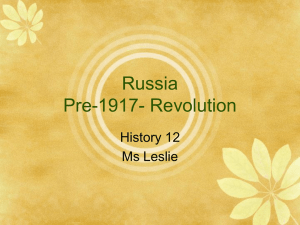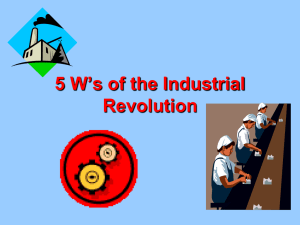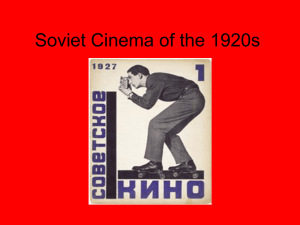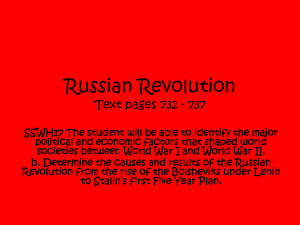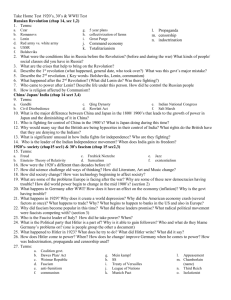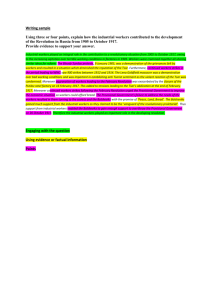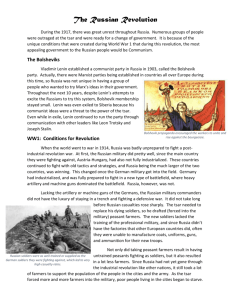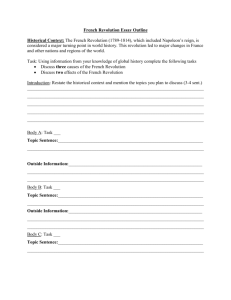Russia in Revolution, 1881-1924: from Autocracy to
advertisement
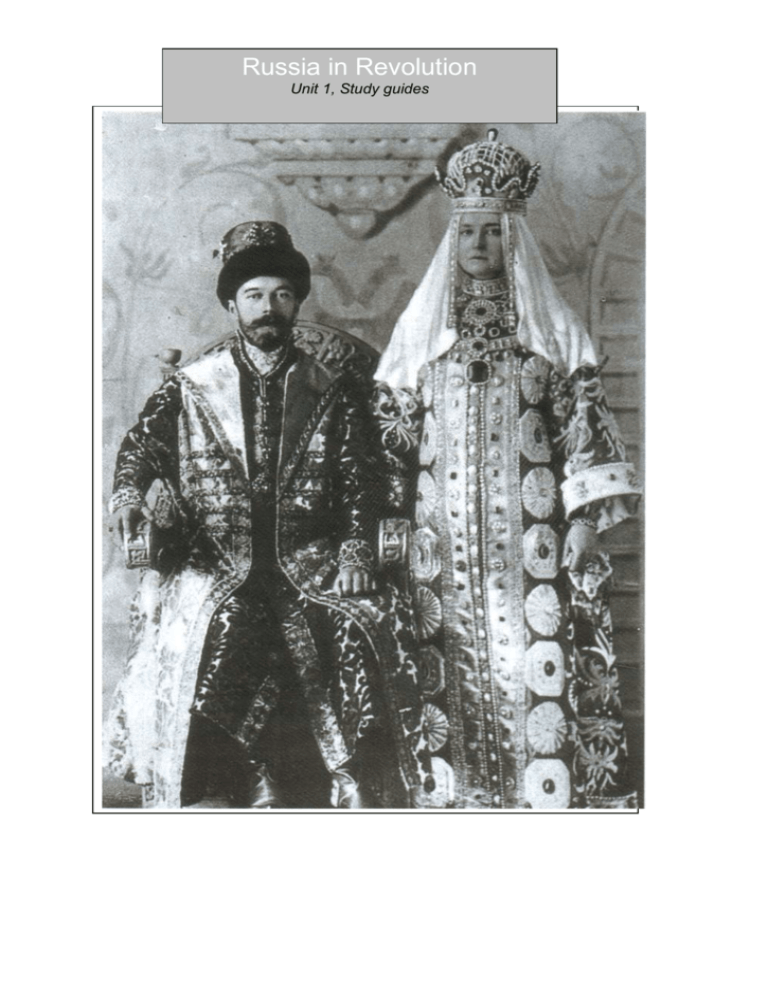
Russia in Revolution Unit 1, Study guides The making of the Revolution Study guide one Section one – Russia before 1881 a. Read p5-8 and complete a table similar to the one below: Russia’s rulers and government Geography Economy Society Ethnic minorities b. Write a paragraph (100 words) summarising why Russia was difficult to govern. c. Read p.8-9 on Alexander II and note down the reforms passed during his reign d. Study the timeline on p. 6 and the information on p.9-10 on the main themes in Russian history. Link the events within the timeline to the themes. Extension task: imagine you are the British ambassador to Moscow. Write a letter back to your government explaining what Russian society was like under the Tsars and any potential problems facing its government. Feel free to illustrate your letter with labelled maps, charts or images from your own research. Section two – The triumph of reaction – the reign of Alexander III, 188194 a. Read p.11-17 and produce two lists of evidence the problems Alexander III faced and they policies he made to resolve them. Try to draw links between the two lists. b. List the problems that Alexander III created c. Study the table on p.17 and make a list of the similarities and differences between Russia at the start and end of Alexander’s reign. Extension task: imagine you are a policy adviser to the new Tsar Nicholas II. Draw up a short report giving him some advice on how to tackle the problems he will inherit from his father. Section three – Economic and social change, the age of Witte a. Read p.19 and create a scales chart recording the successes and problems arising from the emancipation of the serfs b. Read p.20 and list the main features of the ‘Great Spurt’ c. Note down the effects of Witte’s economic reforms using the information on p. 20-1. How successful were his policies? Write a judgement paragraph. Extension tasks: produce factoids on Russia’s Finance Ministers in this period, Ivan Vyshnegradsky (1887-92) and Sergei Witte (1892-1903), recording details of their earlier lives, personalities and policy aims. Section four – Radical parties a. Read p.23-8 and complete a table similar to the one below on the opposition groups in Russia at this time: Aims & ideas Populists Support Methods How radical Social Democrats (Bolsheviks) Social Democrats (Mensheviks) Social Revolutionaries Liberals (Octobrists) Liberals (Kadets) Extension task. Read about the ideas of Karl Marx. Imagine you have been asked to produce an introduction to Karl Marx for a Key Stage 3 class. Produce a poster which simplifies the life of Marx and his key ideas on the four stages of revolution Section five – 1905, a failed Revolution? a. Read p.29-30 and create a spider diagram recording the Social, economic & political of the 1905 Revolution b. Read p.31 and identify as many different immediate causes of the 1905 revolution as you can. Can you link them to the broader long-term causes above? c. Read p.32-5 and list the reasons why the revolution failed. d. Create a scales chart highlighting the achievements and failures of the 1905 Revolution. On balance did the failures outweigh the achievements? Essay practice: ‘How far was the Russo-Japanese War of 1904-5 responsible for the 1905 Revolution?’ The Downfall of the Romanovs Study guide two Section one – Stolypin – repression and reform a. Read p.38 and list the measures used by Stolypin to restore order in Russia after the 1905 Revolution b. List the evidence to suggest Stolypin was a reformer c. Read p.40-41 and complete a table similar to the one below: 1st Duma (1906) 2nd Duma (1907) 3rd & 4th Duma (1907-12 & 1912-14) Political makeup, e.g. liberal or mainly conservative Government interference with elections Key reforms Section two – What impact did WWI have on the government? a. Study the information on p.43-4 of Murphy and construct a timeline from 1914 to Christmas 1916 identifying Russian successes and defeats on either side of the timeline. b. Read Murphy, p.44-45 and note the ways in which WWI affected the Russian economy. c. Read p.45-6 in Murphy and list the reasons why political opposition to the Tsar’s government developed between August 1914 and December 1916. Section three – The February Revolution (1917) a. Read p.48-51 and identify the ways in which demonstrations and strikes developed in St Petersburg. b. Describe how the events of 25 March to 2 March led to the fall of the Tsar c. Complete a venn diagram similar to the one in Murphy, p.51 explaining the similarities and differences between the 1905 and February Revolution. Extension task Read p.81-3 and assess the extent to which the Tsar, his wife & Rasputin were responsible for declining support for the regime using the questions in the activity box on p.83 Essay practice - ‘How far was the First World War responsible for the downfall of the Romanovs in 1917? The Bolshevik Triumph Study guide three Section one – The Provisional Government Read p.54-8 and complete a table assessing the problems facing the PG similar to the one below: Problem What action did the PG take? Success or failure? Government Social & economic problems Peasants First World War Extension task: produce a factoid on Alexander Kerensky Take notes on his early life, political career and his final years Include quotes from contemporaries and historians and a photo (and political cartoons if possible) Write a short judgement on whether he had a positive or negative impact on the PG and post-Revolutionary Russia Use information in Oxley p.104-105 plus any other evidence you may find. Section two – What impact did the return of Lenin have? Read p.59-62 and list the ways in which Lenin’s return changed the course of the Russian revolution. Extension task: study Lenin’s April Theses. Create an acronym to help you remember his 10 points. Section three – July Days & Kornilov Affair Read p.63-4 in Murphy and create a timeline of the July Days highlighting the most important events. Describe how the failure of the July Days affected Lenin and the Bolsheviks Note down ways the Kornilov Affair undermined the authority of the Provisional Government. Section five – The Bolsheviks seizure of power Read p.67-9 in Murphy and construct a timeline of events explaining how the Bolsheviks seized power. Read Murphy p.70 and list the reasons for Bolshevik success. Study the sources on p.108 of Oxley. Do you think the October Revolution was a coup or a popular uprising. Write a short judgement paragraph. Extension task: create a factoid on Trotsky making notes on his ideas, his political career and the part he played in the Revolution and the subsequent consolidation of power. Include useful quotes and a summary of his contribution to the Bolshevik Party. Essay - ‘To what extent is it true to say the Provisional Government faced an impossible task?’ The making of a totalitarian state Study guide four Section one – The consolidation of power Read p. 75 and make a note of the problems facing Lenin when he came to power List the key changes introduced by the Treaty of Brest-Litovsk from the information on p.75 Read about the Constituent Assembly on p.76-77 and note why it lasted for only 1 day. Section two – Why were the Bolsheviks successful in winning the Civil War? Read Murphy p.78-9 and list the reasons why the Bolsheviks faced so much opposition 1918 Did the Reds win by default? Study the information in Murphy p.80-3 and create a scales chart weighing up the strengths of the Reds against the weaknesses of the Whites. Write a summary of your findings (100 words). Section three – War Communism Read p. 84 and note the ways in which Lenin attempted to introduce a communist-style economy between December 1917 and June 1918 Note down the main feature of War Communism on p.84-5 Create a scales chart to evaluate the success or failure of War Communism using the information and evidence on p.85-6 Section four - The New Economic Policy? Read p.87-8 and list the main reasons why the Bolsheviks introduced the NEP. Read Murphy p.88 and list the main decisions taken by the 10th Party Congress. Make a list of the positive and negative impacts of the NEP using the information on p.89 Section five – The creation of the USSR Read p. 90 and note ways in which the creation of the USSR changed the way Russia was governed. List the main features of Lenin’s dictatorship using the evidence on p.90-91. Complete a chart similar to the one on p.91 Extension task: prepare notes for a debate on whether Lenin was little more than a Red Tsar Essay - ‘How far was the Communist dictatorship under Lenin different from the Tsarist autocracy in the reign of Alexander III?’
